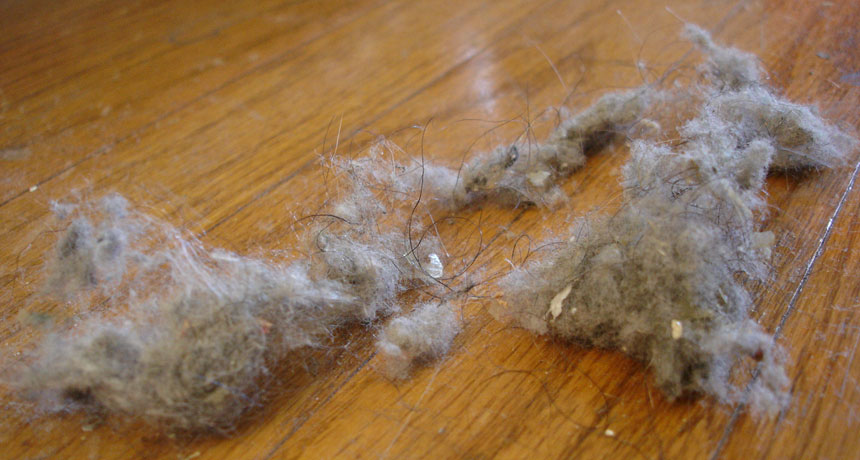Can house dust make us fat?
Fats lurking in house dust may signal cells in the body to fatten up

House dust contains fats that can spur human fat cells to grow, potentially promoting obesity.
Eirik/Wikimedia Commons
By Beth Mole
Dust bunnies that breed under furniture may be bad news for waistlines, a new study suggests. But it’s far too early to add dusting to a weight-loss plan.
Dietary fats and other materials that make up indoor dust can send a signal to human fat cells, telling them to grow.That process, in turn, might slow the body’s metabolism, which is the rate at which it burns energy. Such changes could add to any weight problems a person might have. Researchers reported their new findings online July 14 in Environmental Science & Technology.
“What that means to long term health and certain diseases, we don’t know yet,” says Heather Stapleton. One of the study’s authors, she works at Duke University in Durham, N.C. As an environmental chemist, she studies chemical processes that occur in everyday settings. But, she notes, her team’s findings also raise a question of whether pollutants in dust might play some role in a growing, global epidemic of obesity.
Stapleton and her colleagues collected dust samples from homes and offices. Some materials in the dust could turn on a protein called PPAR-gamma1. It’s found in many human tissues. Switching this protein on can cause fat cells to grow. Researchers think this protein may be involved in obesity. As such, pollutants that turn on this protein might be thought of as “obesogens” — a new term for chemicals that can promote obesity.
In the lab, the researchers worked with cells that contain PPAR-gamma1. This protein turned on when the cells were exposed to less than a milligram of some of the sampled dust. For perspective, children may ingest around 50 milligrams of dust each day, the authors note.
Stapleton’s team had initially suspected that certain pollutants shed by furniture and other products around the home, such as flame retardants, might be the culprits in dust. After all, studies had hinted that some of these chemicals can turn on PPAR-gamma1.
But a second study by those researchers now find hints that certain fats are mostly to blame. One of those fats — oleic (Oh-LAY-ik) acid — occurs naturally in many animals and vegetable oils. Cooking oils may spew some of these fats into the air, where they eventually find their way into house dust. Or, the authors say, the fats might enter house dust as part of the hair or skin cells shed by people or pets. This second study also appeared online July 14 in the same journal.
The findings are “intriguing,” says Mitchell Lazar. He directs the Institute for Diabetes, Obesity and Metabolism at the University of Pennsylvania in Philadelphia. Still, he says, “these findings need to be taken as very preliminary.” Indeed, he adds several cautions about how the findings should be interpreted.
For one thing, people eat these fats in foods all of the time An 85 gram (3-ounce) portion of steak, Lazar notes, contains 3 grams of oleic acid. “That is likely to be a lot more than would be consumed from indoor dust.”
Power Words
(for more about Power Words, click here)
contaminant Pollutant; achemical, biological or other substance that is unwanted or unnatural in an environment such as water, soil, air, or food. Some contaminants may be harmful in the amounts at which they occur or if they are allowed to build up in the body over time.
environmental chemistry The scientific study of potentially toxic chemicals that may pollute the environment or food supply.
flame retardants Chemical coatings added to products, such as pyjamas, plastics, foam and furniture, to suppress or delay how fast they might burn in a fire.
metabolism The set of life-sustaining chemical reactions that take place inside cells and bigger structures, such as organs. These reactions enable organisms to grow, reproduce, move and otherwise respond to their environments.
obesity Extreme overweight. Obesity is associated with a wide range of health problems, including type 2 diabetes and high blood pressure.
obesogens Any of a host of different chemicals in the environment — many of them industrial pollutants — that appear capable of signaling the body to fatten up.
proteins Compounds made from one or more long chains of amino acids. Proteins are an essential part of all living organisms. They form the basis of living cells, muscle and tissues; they also do the work inside of cells. The hemoglobin in blood and the antibodies that attempt to fight infections are among the better-known, stand-alone proteins.Medicines frequently work by latching onto proteins.
tissue Any of the distinct types of material, comprised of cells, which make up animals, plants or fungi. Cells within a tissue work as a unit to perform a particular function in living organisms. Different organs of the human body, for instance, often are made from many different types of tissues. And brain tissue will be very different from bone or heart tissue.







